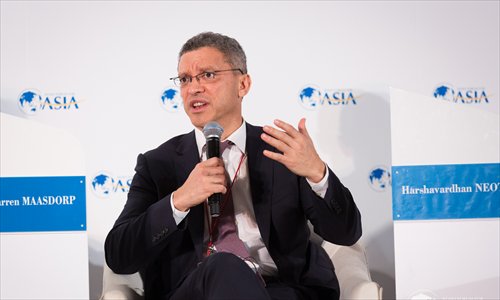New Development Bank not a rival institution but complementary to AIIB

Leslie Maasdorp Photo: Courtesy of Boao Forum
Editor's Note:After signing the Headquarters Agreement with the government of China in February, the New Development Bank (NDB), a multilateral development bank operated by the BRICS countries - Brazil, Russia, India, China and South Africa - has recently started its recruitment process. Global Times reporter Wang Jiamei (GT) interviewed Leslie Maasdorp (M), vice president of the NDB, during the Boao Forum for Asia to get more information about the new BRICS bank.
GT: Other multilateral banks like the World Bank are reportedly facing capital problems and are trying to find a solution. How will your bank ensure a supply of capital?
M: Firstly, we are new, with a high paid-in capital ratio. If you look at each of our member states, the amount of capital they've contributed to the NDB versus other multilateral banks, it's quite a high proportion. We will have over the next number of years $10 billion in paid-in capital.
GT: What do you think of the relationship between the NDB and the Asian Infrastructure Development Bank (AIIB)?
M: The AIIB and NDB are both headquartered in China and there is a strong relationship between these two institutions. Within the infrastructure space, there is such a huge funding gap that all of these institutions can work together. All of us contribute to filling that funding gap. What sets the AIIB and NDB apart is that we are focused on the five BRICS countries, while the AIIB is focused on Asia, so we have a geographical difference.
But for big regional projects in Asia, we very much welcome the opportunity to partner with the AIIB to co-finance some projects. Rather than setting up a rival institution, we consider the NDB as being complementary to the existing financial architecture.
GT: We heard that the NDB is about to approve its first set of project proposals in April. What is the latest progress?
M: During the next month we will make an announcement in this regard. I cannot discuss it now, but there is a very strong focus on renewable energy in the first batch of projects. We are also looking at potentially issuing a green bond in the Chinese market, and our projects will all be environmentally sustainable.
GT: When you issue loans to support these projects, will there be any currency preference?
M: Our mandate is to issue bonds in both local currencies and the US dollar. So we will be able to tap both international capital markets and local ones. The Chinese market will be the first in which we issue bonds. Although it underwent a bit of depreciation last year, the yuan is a very stable currency.
Secondly, the bond market in China is very well developed. We plan to issue a bond during the second quarter of this year, and to raise something between 3 and 5 billion yuan.
GT: Could you share with us your thoughts on the outlook for Asian economies?
M: China will continue to be a strong engine in Asia and also for the world economy. Despite the slower growth, it would be a great achievement to grow a $10.5 trillion economy at a rate of 6.5 percent. That should not be underrated at all. But because the economy is slowing down, it impacts very directly for example on the BRICS economies, because China is a major trade partner.
Many of these economies should find ways to diversify from commodities. China is trying to encourage innovation and to move toward a consumption-led economy, as well as developing its services sector and moving away from dependence on resources. Other BRICS economies are trying to do the same thing.